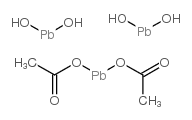盐基性醋酸铅

盐基性醋酸铅结构式

|
常用名 | 盐基性醋酸铅 | 英文名 | lead subacetate |
|---|---|---|---|---|
| CAS号 | 1335-32-6 | 分子量 | 807.71700 | |
| 密度 | N/A | 沸点 | 117.1ºC at 760mmHg | |
| 分子式 | C4H10O8Pb3 | 熔点 | 75℃ | |
| MSDS | 中文版 美版 | 闪点 | N/A | |
| 符号 |


GHS08, GHS09 |
信号词 | Danger |
|
Mast cell heterogeneity in man. I. Histologic studies of the intestine.
Int. Arch. Allergy Appl. Immunol. 76(3) , 232-6, (1985) We have studied the distribution and abundance of histochemically distinct mast cell subpopulations in the normal small and large intestine of man. One subpopulation has histochemical properties similar to the functionally distinct intestinal mucosal mast cel... |
|
|
Inhibition by magnesium and calcium acetates of lead subacetate- and nickel acetate-induced lung tumors in strain A mice.
Cancer Res. 44(4) , 1520-2, (1984) The ability of the physiologically essential divalent metals calcium and magnesium to inhibit the tumorigenic activities of lead and nickel towards the lungs of strain A mice was investigated. The tumorigenic salts lead(II) subacetate and nickel(II) acetate w... |
|
|
Numbers and heterogeneity of mast cells in the male genital tract of the rat.
Int. Arch. Allergy Appl. Immunol. 88(3) , 360-2, (1989) Normal adult rats were used to quantitate and characterize mast cells in the male genital tract. The tissues were either fixed in a fixative containing formalin (Schaffer solution) or with basic lead acetate (BLA) to identify 'connective-tissue mast cells' an... |
|
|
Effects of dietary calcium acetate on lead subacetate carcinogenicity in kidneys of male Sprague-Dawley rats.
Carcinogenesis 6(2) , 279-82, (1985) Seven groups of 4-week-old male Sprague-Dawley rats, 30 animals/group, were fed for 18 months a commercial chow diet with or without 1% admixture of lead subacetate (Pb-Acet) and 0, 0.3, 1, 3 and 6% of calcium acetate (CaAcet). Feeding a 3% CaAcet-only diet d... |
|
|
Fusarium oxysporum infection of stasis ulcer: eradication with measures aimed to improve stasis.
Mycoses 54(4) , e205-7, (2011) Fusarium species may cause localised skin infections in immunocompetent individuals. At least half of these infections are preceded by skin breakdown. The lesions are characterised by slow progression and good response to therapy. Here we present a 60-year-ol... |